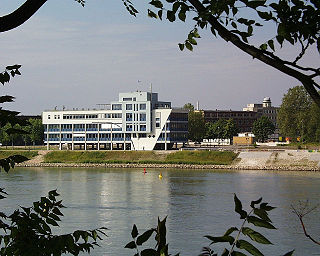
The Palatinate, or the Rhenish Palatinate (Rheinpfalz), is a historical region of Germany. Palatinate occupies most of the southern quarter of the German federal state of Rhineland-Palatinate (Rheinland-Pfalz), covering an area of 2,105 square miles (5,450 km2) with about 1.4 million inhabitants. Its residents are known as Palatines (Pfälzer).

Wellsburg is a city in Grundy County, Iowa, United States. The population was 720 at the 2020 census, a slight increase from 716 in 2000. It is part of the Waterloo–Cedar Falls Metropolitan Statistical Area. The city is named for George Wells, an early settler in the region.

Ludwigshafen, officially Ludwigshafen am Rhein, is a city in the German state of Rhineland-Palatinate, on the river Rhine, opposite Mannheim. With Mannheim, Heidelberg, and the surrounding region, it forms the Rhine Neckar Area.
The Rhein-Pfalz-Kreis is a district (Kreis) in the east of Rhineland-Palatinate, Germany.

Treptower Park is a park alongside the river Spree in Alt-Treptow, in the district of Treptow-Köpenick, south of central Berlin.

The East Asia Institute is a public research centre, founded in 1989 as part of the Ludwigshafen University of Applied Sciences. It offers four year or eight-semester programs (BA) in international business management, supplemented with cultural and language studies in China, Japan, or Korea-related topics and regions.

Lauste is a district and a suburb of the city of Turku, Finland. It is located in the eastern part of the city, bordering the neighbouring city of Kaarina. It is rather densely populated, having a population of 3,405. Its population is rapidly decreasing, however – it has an annual population growth rate of -5.73%, which is the lowest of all districts of Turku.

The Rhine-Neckar Metropolitan Region, often referred to as Rhein-Neckar-Triangle, is a polycentric metropolitan region located in south western Germany, between the Frankfurt/Rhine-Main region to the North and the Stuttgart Region to the South-East.

Böhl-Iggelheim is a municipality in the Rhein-Pfalz-Kreis, in Rhineland-Palatinate, Germany. It has about 8,200 inhabitants and is situated approximately 15 km southwest of Ludwigshafen, and 10 km northwest of Speyer.

The Bint Jbeil District is a district in the Nabatiyeh Governorate of Lebanon. The capital of the district is Bint Jbeil.

Friedrich-Ebert-Halle is an indoor arena located in Ludwigshafen, Germany, which can accommodate 2,250 guests. The facility was designed by Roland Rainer and completed in 1965. It is used for sporting events, fairs, exhibitions and concerts. Past performers include The Kinks, The Who, Dio, Rainbow and Whitesnake.

The Konrad Adenauer Bridge is one of two road bridges crossing the Rhine between the German cities of Mannheim and Ludwigshafen am Rhein. The other bridge is the Kurt Schumacher Bridge.

Crooswijk is a neighborhood of Rotterdam, Netherlands. Crooswijk lies between the districts Kralingen, Oude Noorden and Centrum. Crooswijk was once known for its Marines barracks. Many streets bear witness to a military history of the Marine Corps: Tamboerstraat, Pijperstraat, Schuttersveld, Excercitiestraat, Vaandrigstraat. Crooswijk also has an industrial past. Jamin, Heineken Brewery and many abattoirs were established there. These industries have given way to housing. On the Crooswijksesingel is only the monumental building of Heineken still standing. Crooswijk is one of the original people's neighborhoods of Rotterdam and the district is strongly associated with the 'real' Rotterdammer. The Crooswijk is sometimes called: "The poorest part of the Netherlands", or: "The poorest part of Rotterdam". This is because the average income of the people living there is lower than other places.
The Miró Wall is a ceramic tiled wall designed by Spanish artist Joan Miró for the Wilhelm Hack Museum in Ludwigshafen, Germany. The wall, which comprises 7,200 tiles, is 55 metres (180 ft) wide and 10 metres (33 ft) high.

The University of Applied Sciences Ludwigshafen is a public university located in Ludwigshafen, Germany. It was founded in 1965 as Higher School of Commerce Ludwigshafen. In 1971 it became part of the University of Applied Sciences Rhineland Palatinate, which split up into seven autonomous universities in 1991.

The Pfalzbau is a convention centre located in Ludwigshafen, Germany. The building is used primarily for theatre, concerts, congresses and fairs. The auditorium has a seating capacity of 1,171.

The Betzenberg is a 285-metre-high hill in the German city of Kaiserslautern. It rises about 50 metres above the city and gives its name to the quarter in which it stands. It was well known because it also gave its name to what is now the Fritz Walter Stadium.

The Giant Cask or Giant Barrel, is a tourist attraction in the Palatine spa and district town of Bad Dürkheim in the state of Rhineland-Palatinate. The wine barrel has a diameter of 13.5 metres, a volume of about 1,700,000 litres or 1,700 m³ and is thus the largest cask in the world. However, it is not used for the storage of wine, but houses a restaurant.

The Ludwigshafen University Library supplies the Ludwigshafen University of Business and Society with literature for research and higher education purposes. Users are primarily students and lecturers, although the library is open to the general public. In the CHE ranking the Ludwigshafen University Library holds a top position in the rated courses of study.
Events from the year 1865 in Germany.




















